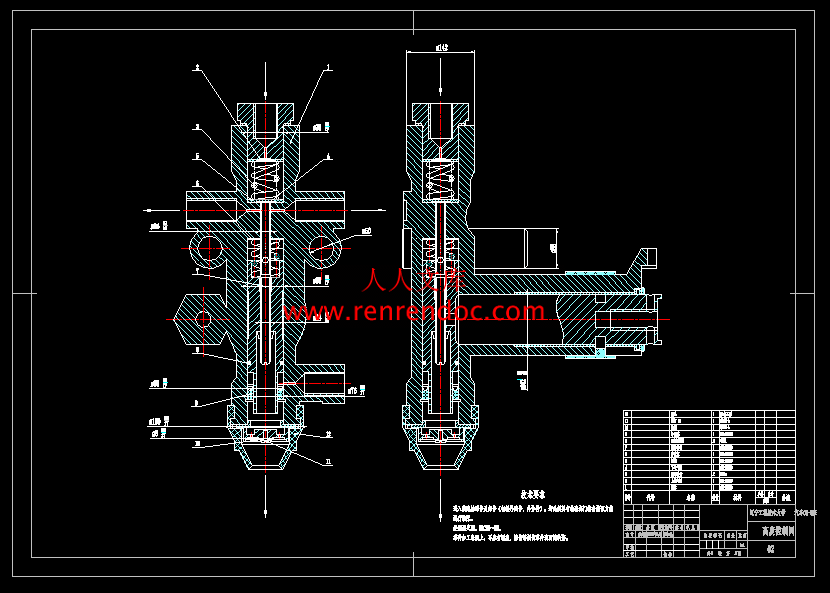重型载货汽车的悬架系统结构的设计
62页 25000字数+说明书+外文翻译+开题报告+4张CAD图纸
减振器.exb
减振器装配图.dwg
外文翻译--汽车悬架如何工作.doc
悬架原理图.dwg
悬架原理图.exb
悬架空气弹簧.dwg
悬架空气弹簧.exb
悬架高度控制阀.exb
悬架高度控制阀装配图.dwg
目录.doc
重型载货汽车的悬架系统结构的设计开题报告.doc
重型载货汽车的悬架系统结构的设计论文.doc
摘要
随着国民经济的高速发展,我国公路运输需求将在一段较长时间内保持持续增长。重型载货汽车品种多、应用广泛,在国民经济建设中发挥巨大作用。由于重型汽车工作条件比较恶劣、弯道多、坡路多、转弯半径小,车辆频繁转向与制动,并长期在满载、振动与冲击载荷下工作,振动都比较强烈。为保证车辆具有良好的高速行驶平顺性,实现质量高运输,并减小对路面的破坏程度,先进的车辆悬架技术在重型卡车上被广泛研究和采用。
空气悬架由弹性元件、导向装置、减振器、缓冲块和横向稳定器等组成,囊式空气弹簧是弹性元件其中一种,它含有帘布层结构的橡胶气囊内冲入空气,并以空气为介质,利用空气可以压缩的特点来实现弹性作用。通过高度控制阀,来保证车身高度不随汽车载荷变化而变化,保证汽车的平顺性和稳定性。减振器是保证汽车在使用期限行驶平顺性的性能稳定的主要元件。
关键词:导向装置;空气弹簧;高度控制阀;减振器
ABSTRACT
With the high-speed development of domestic economy,our nation’s road transportation will keep increasing quickly and continuously in a long period.Heavy trucks play an essential role in the economy construction for its merits,such as abundant sorts,comprehensive application.Usually the work conditions of the heavy truck is execrable,which is full of bend road,slope road;Truck must swerve with small radius,turn and brake high frequently,and it is also used under the condition of full—load vibration and striking,the vibration is serious,which is dangerous to drivers’body.In order to provide the heavy truck with high-speed ride comfort and quality of transit,at the same time decrease the disastrous impact to the road,advanced vehicle suspension technology has been invesfigated applied extensively in heavy truck industry.
Air suspension of elastic component, guiding device, shock absorber, transverse stabilizer blocks and a buffer, cystic components, such as air spring flexible components, it contains one layer structure of air curtain inside irruptive air, rubber and air as medium, the characteristics of air can be compressed to achieve flexibility. Through the height valve body height, to ensure that no changes with the automobile loading, guarantee the stability and car ride. Car shock absorber is to ensure that the use of the performance period of ride comfort and stability of the main components.
Key words:orientation device;air spring;height control valves;shock absorber
目录
前言1
1 绪论2
1.1 悬架的概述2
1.2 悬架的分类4
1.3 重型载货汽车悬架系统目前的工作状况5
1.4 悬架技术的研究现状及发展趋势6
1.4.1悬架技术的研究现状6
1.4.2悬架技术的发展趋势6
1.4.3悬架设计的技术要求7
2 空气悬架结构8
2.1 空气悬架结构简介8
2.1.1空气悬架系统的基本结构8
2.1.2空气弹簧的类型9
2.1.3导向机构10
2.1.4高度控制阀10
2.2 空气悬架系统的工作原理10
3 悬架主要参数的确定12
3.1 载货汽车的结构参数12
3.2 悬架静挠度12
3.3 悬架动挠度14
3.4 悬架弹性特性14
4 弹性元件的设计16
4.1 空气弹簧力学性能17
4.1.1空气弹簧刚度计算17
4.1.2空气弹簧固有频率的计算19
4.1.3空气弹簧的刚度特性分析20
4.2 高度控制阀21
5 悬架导向机构的设计23
5.1 悬架导向机构的概述23
5.2 横向稳定杆的选择24
5.3 侧顷力臂的计算方法25
5.4 稳定杆的角刚度计算26
5.5 悬架的侧倾角校核27
6 减振器机构类型及主要参数的选择计算29
6.1 分类29
6.2 主要参数的选择计算31
7 技术与经济性分析36
8 结论38
参考文献39
致谢40
附录A 译文41
附录B 外文原文48
机械装置的基本规律指出:载货汽车良好的舒适性,操纵稳定性及良好的承载能力在使用定刚度和定阻尼减震器的传统悬架中是不能同时满足的。因此,传统的悬架在设计过程中不可避免的要进行乘坐舒适性和操纵稳定性的折衷,尽管近年来传统悬架在结构上的不断更新和完善,采用优化设计方法进行设计,已使汽车(特别是轿车)的乘坐舒适性和操纵稳定性有很大提高,例如横臂式独立悬架、纵臂式独立悬架、车轮沿主销移动的悬架(烛式和麦弗逊式)等等的采用,但传统悬架系统仍然受到许多限制,如最终设计的悬架参数(弹簧刚度、减振器阻尼系数)是不可调节的,致使传统悬架系统只能保证汽车在一种特定的道路和速度条件下达到性能最优的折衷。
1.4.2悬架技术的发展趋势
当前在大型商用汽车、半挂车中采用空气悬架系统越来越多。空气悬架突出的优点是平顺性好,维修少,寿命长,对承运的乘客和货物的保护比钢板弹簧悬架有着很大的提高,而对整车和路面的损坏程度也大大减少。
钢板弹簧在不同的载荷下产生不同的弯曲,这样会导致整车到地面的距离总是在发生变化,如果保持弹簧的弹性而增加载荷的话,这会降低弹簧的固有频率甚至使弹簧的特性发生改变。
空气弹簧基于空气的可压缩性,封闭在气囊里的空气是弹性元件,空气弹簧通过不同气囊的压力来平衡不同的载荷。空气弹簧的固有频率稳定,因此它的弹性性能也稳定,这样就意味着空气弹簧更加的接近理想状态。
随着我国高速公路的迅速发展,公路运输量的增加,对汽车性能的要求也越来越高,空气悬架凭着其自身的优越性能在货车上的应用必将越来越广泛。另外,随着重型载货汽车对路面的破坏机理的研究及认识的进一步加深,以及政府对高速路养护的进一步重视,空气悬架在重型货车上的应用也必将进一步增加。因此,对空气悬架的设计进行深入的研究也显得越来越重要。
1.4.3悬架设计的技术要求
对悬架提出的设计要求有:
(1)保证汽车有良好的行驶平顺性
(2)具有适合的衰减振动的能力
(3)保证汽车具有良好的操纵稳定性
(4)汽车制动或加速时,要保证车身稳定性,减少车身纵倾,转弯时车身侧倾角要适合
(5)有良好的隔声能力
(6)结构紧凑、占用空间尺寸要小
(7)可靠地传递车身与车轮之间的各种力和力矩,在满足零部件质量要小的同时,还要保证有足够的强度和寿命


 川公网安备: 51019002004831号
川公网安备: 51019002004831号